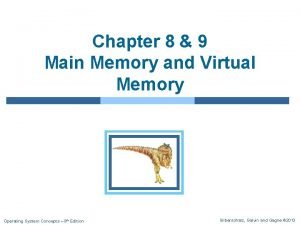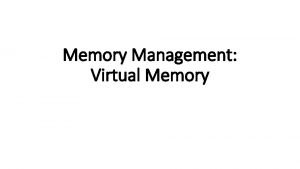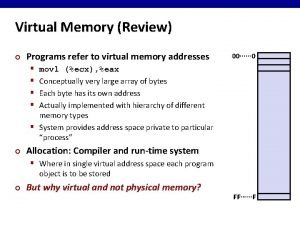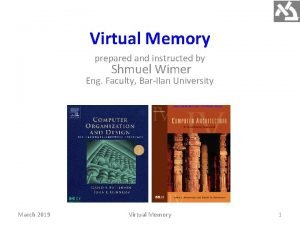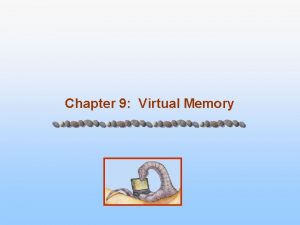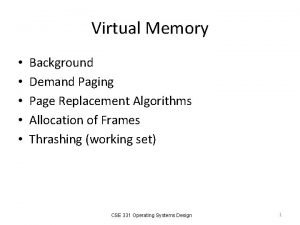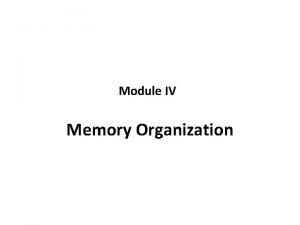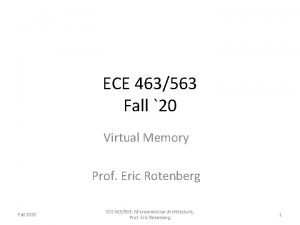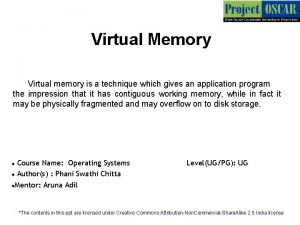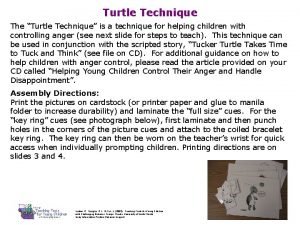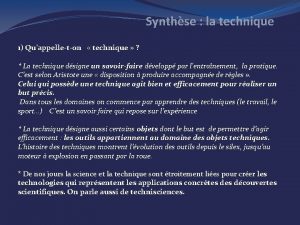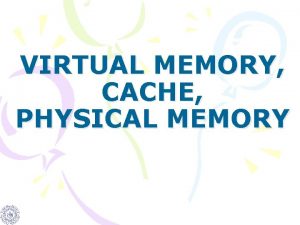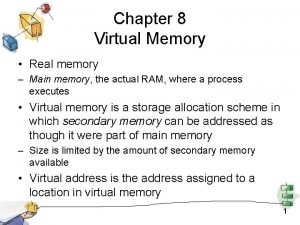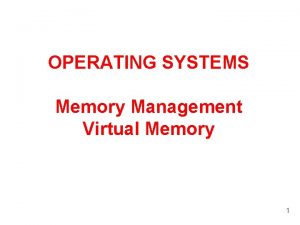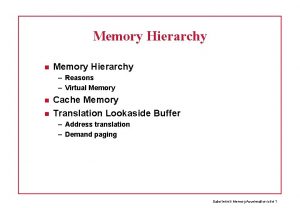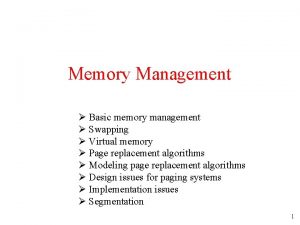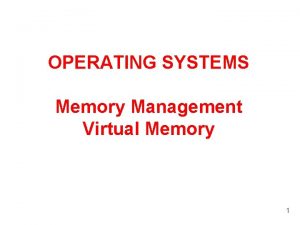VIRTUAL MEMORY VIRTUAL MEMORY Virtual memory technique is



















- Slides: 19

VIRTUAL MEMORY

VIRTUAL MEMORY • Virtual memory technique is used to extents the size of physical memory • When a program does not completely fit into the main memory, it is divided into segments. • The segments which are currently being executed are kept in the main memory and remaining segments are stored in the secondary memory • If an executing program needs a segment which is not currently in the main memory, the required segment is copied from secondary memory

VIRTUAL MEMORY • When a new segment of a program is to be copied into main memory it must replace another segment • Then the OS moves the program automatically between main memory and secondary memory and this technique is called Virtual memory • The addresses that issued by the processor are called virtual or logical address

VIRTUAL MEMORY • This address are translated into physical addresses by memory management unit (MMU) • If the referenced address is not in the main memory, its contents must be brought into a suitable location in the main memory before they can be used

VIRTUAL MEMORY

VIRTUAL MEMORY • Address Translation • A simple method for translating virtual addresses into physical addresses is to assume that all programs and data are composed of fixed-length units called pages, each of which consists of a block of words that occupy contiguous locations in the main memory

VIRTUAL MEMORY • Pages commonly range from 2 K to 16 K bytes in length. • Pages should not be too small, because the access time of a magnetic disk is much longer (10 to 20 milliseconds) than the access time of the main memory.

VIRTUAL MEMORY • considerable amount of time to locate the data on the disk, but once located, the data can be transferred at a rate of several megabytes per second. • On the other hand, if pages are too large it is possible that a substantial portion of a page may not be used, yet this unnecessary data will occupy valuable space in the main memory.

VIRTUAL MEMORY • The virtual-memory mechanism bridges the size and speed gaps between the main memory and secondary storage and is usually implemented in part by software techniques. • Conceptually, cache techniques and virtual memory techniques are very similar.

VIRTUAL MEMORY • A virtual-memory address translation method based on the concept of fixed-length pages is shown schematically in Figure • Each virtual address generated by the processor, whether it is for an instruction fetch or an operand fetch/store operation, is interpreted as a virtual page number (high-order bits) followed by an offset (low-order bits) that specifies the location of a particular byte (or word) within a page. • Information about the main memory location of each page is kept in a page table.

VIRTUAL MEMORY

VIRTUAL MEMORY • This information include; the main memory address where the page is stored and the current status of the page. • An area in the main memory that can hold one page is called a page frame • The starting address of the page table is kept in a page table base register • By adding the virtual page number to the contents of this register. the address of the corresponding entry in the page table is obtained. • The contents of this location give the starting address • of the page if that page currently resides in the main memory.

VIRTUAL MEMORY • Each-entry in the page table also includes some control bits that describe the status of the page while it is in the main memory • One bit indicates the validity of the page that is, whether the page is actually loaded in main memory • This bit allows the operating system to invalidate the page without actually removing it

VIRTUAL MEMORY • Another bit indicates whether the page has been modified during its resident in the memory as in cache memories, this information is needed to determine whether the page shotlid he written back to the disk before it is removed from the main memory to make room for another page.

VIRTUAL MEMORY • Other control bits indicate various restrictions that may be imposed on accessing the page. • For example, a program may be given full read and write permission, or it may be restricted to read accesses only.

VIRTUAL MEMORY • The page table information is used by the MMU for every read and write access, so Ideally, the page table should be situated within the MMU. • Unfortunately the page table may be rather large, and since the MMU is normally implemented as part of the CPU chip (along with the primary cache). • it is impossible to include a complete age table on this chip. • Therefore, the page table is kept in the main memory.

VIRTUAL MEMORY • However a copy of a small portion of the page table can be accommodated within the MMU. • This portion consists of the page table entries that correspond to the most recently accessed pages. • A small cache, usually called the Translate look aside Buffer (TLB)

VIRTUAL MEMORY

VIRTUAL MEMORY
 Virtual memory
Virtual memory Virtual memory in memory hierarchy consists of
Virtual memory in memory hierarchy consists of Eidetic memory vs iconic memory
Eidetic memory vs iconic memory Prototype in semantics
Prototype in semantics Primary memory and secondary memory
Primary memory and secondary memory Shared memory vs distributed memory
Shared memory vs distributed memory Explicit memory
Explicit memory Logical address
Logical address Long term memory vs short term memory
Long term memory vs short term memory Which memory is the actual working memory?
Which memory is the actual working memory? Internal memory and external memory
Internal memory and external memory Demand paging in virtual memory
Demand paging in virtual memory What is virtual memory
What is virtual memory Virtual memory address translation
Virtual memory address translation Virtual address
Virtual address Virtual memory
Virtual memory Virtual memory os
Virtual memory os Virtual memory
Virtual memory Virtual memory organization
Virtual memory organization Virtual memory
Virtual memory











